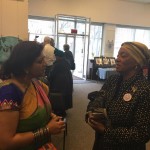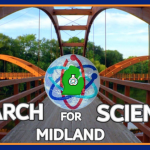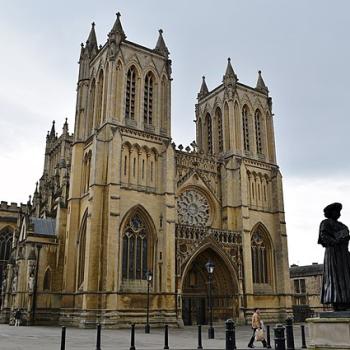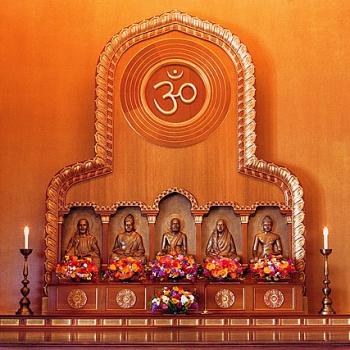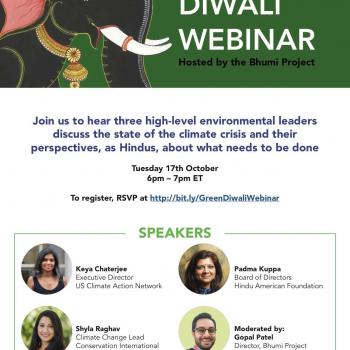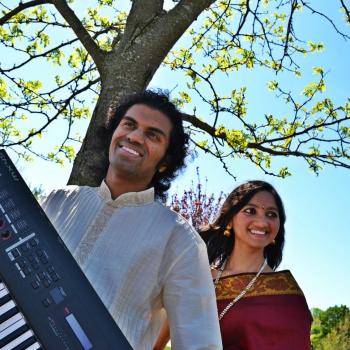During my childhood, my father referenced Albert Einstein often, with quotes like “Science without religion is lame and religion without science is blind.” Einstein was deeply interested in the relationship between religion and science. He gave considerable attention to the humanities and the pursuit of peace through his writing. His scholarship went beyond his particular fields of academic study, and addressed the apparent conflict between scientific inquiry and religious practice. He published a piece in the New York Times Magazine, on November 9, 1930, presented on science and religion at Princeton and other venues in the late 30s-early 40s, and wrote an article in 1948 in the Christian Register entitled “Religion and Science: Irreconcilable?”
The daughter of a scientist whose devotion was a pillar of her Hindu practice, I had always been assured of compatibility between religion and science by both my parents. Family dinners involved conversations with the poet-cum-English scholar and the molecular biologist steeped in bhakti, where we lingered over the spiritual, philosophical and phenomenological aspects of life. My understanding of this congruence between science and religion continued to develop as I studied AP Bio in the suburbs of DC and Physics in the heat of Hyderabad. This cross continental high school experience gave me a window into the difference between Western and Eastern understandings of religion and its impact on science: the exclusive, exemplified by “Jesus saith unto him, I am the way, the truth, and the life: no man cometh unto the Father, but by me.” (John 14:6 King James Version) and the inclusive, “Truth is one; sages call it by various names.” (Rig Veda, Hymn 1, book 164, verse 46). Understanding this foundational philosophy eventually empowered my own parenting as I raised my Hindu kids in America. It gave me the foundations to write about one of the Hindu stories of Creation for my seminary class; and about the lack of controversy over evolution and creation in Hinduism at the time of Darwin’s bicentennial for my temple’s quarterly magazine. So in light of the upcoming National Geographic series Genius, whose first season is based on Walter Isaacson’s biography of Albert Einstein, I decided to (re)read some of Einstein’s famous essays on the intersection of science and religion.
Simplifying Einstein’s division of religion into three progressive stages, the first two involve varying levels of an anthropomorphic conception of God, based on fear or on morality. The third stage he refers to is cosmic religious feeling, of which he says, “The religious geniuses of all ages have been distinguished by this kind of religious feeling, which knows no dogma and no God conceived in man’s image; so that there can be no church whose central teachings are based on it.” Einstein even maintained “that the cosmic religious feeling is the strongest and noblest motive for scientific research,” and lays out the reasoning for a Judeo-Christian or Western conflict between science and religion.
According to Einstein, an omnipotent, benevolent God is accessible to the most undeveloped mind. He felt there is weakness in the ideal of a personal God who guides all human actions and thoughts, and metes out punishment based on His judgement, because it is difficult to hold “men responsible for their deeds and thoughts before such an almighty Being.” When a religious community insists that it alone possesses the absolute Truth, and where the “religious stock of ideas contains dogmatically fixed statements on subjects which belong in the domain of science,” science and religion seem irreconcilable.
Einstein pointed out that in defining science and religion, we may come to a common understanding more easily about what science is than what religion is. According to one of his definitions, “Science is the century-old endeavor to bring together by means of systematic thought the perceptible phenomena of this world into as thoroughgoing an association as possible.” And instead of defining religion, he described a person “who is religiously enlightened…to be one who has, to the best of his ability, liberated himself from the fetters of his selfish desires and is preoccupied with thoughts, feelings, and aspirations to which he clings because of their superpersonal value.”
This ideal of being liberated is espoused in one of my favorite verses from the Bhagavad Gita, the Hindu scripture that many Hindus and non-Hindus have found inspiration in:
Karmanye vadhikaraste Ma Phaleshu Kadachana, Ma Karmaphalaheturbhurma Te Sangostvakarmani
You have the right to work only but never to its fruits. Let not the fruits of action be your motive, nor let your attachment be to inaction.
While Einstein divided the perception of God into three stages, the various Hindu conceptions of the Divine include a division into two: Nirguna Brahman and Saguna Brahman. Brahman is the Infinite, believed to be ever-present, all-powerful, and beyond comprehension, (further details of the Hindu concepts of God are found here). Perception of God as Nirguna/Saguna provides a path to pluralism: Nirguna Brahman is an impersonal, formless God, beyond conception, beyond reasoning, beyond thought; and Saguna Brahman, a personal God with good qualities and of many forms. This underlying pluralism provides compatibility, not conflict, between religion and science.
As explained in HAF’s Hinduism 101 primer on science in Hinduism, “science and art take on a sacred dimension, and the six fields of study outlined in the Vedangas (limbs of the Vedas) – grammar, phonetics, meter, etymology, ritual, and astrology – are considered particularly sacred. The Upa Vedas are also considered sacred and include medicine, music and dance, the martial arts, and architecture.” In addition, Hindu religious practice – like cutting edge science – should not operate from hubris. Humility and curiosity are critical, and include questioning ideas, exploration and contemplation. With such a pluralistic approach where understanding the eternal mysteries of existence is considered a part of religious practice, and inquiry is essential, it is easy to understand why Hindus find harmony between religion and science.
So it was an easy choice for HAF, an organization whose Board I serve on, to join nearly 200 diverse organizations as partners in the National March for Science, mixing of science and religion. Many will gather on Earth Day, April 22, 2017, in Washington, DC, and hundreds of other venues around the world, to call for evidence-based policy and reiterate the vital role science plays in ensuring public health, safety and welfare. As Einstein said, “true religion has been ennobled and made more profound by scientific knowledge.” In recognition of this, perhaps it is time for people of all faiths (and none) to see the need to advocate for science and march.
This article is featured as part of a symposium on “GENIUS.” Tune into the premiere of “GENIUS” on National Geographic April 25.

